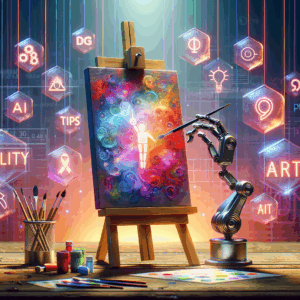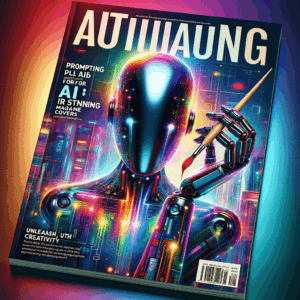
AI-Generated Style Guides: Must-Have For Effortless Design
- Understanding the Role of Style Guides in Design
- The Benefits of AI-Generated Style Guides
- 1. Time Efficiency
- 2. Consistency Across Platforms
- 3. Data-Driven Decisions
- How AI Generates Style Guides
- Natural Language Processing (NLP)
- Image Recognition
- Algorithmic Design Suggestions
- Key Components of an AI-Generated Style Guide
- 1. Color Palette
- 2. Typography
- 3. Layout Guidelines
- Practical Use Cases of AI-Generated Style Guides
- E-commerce
- Startups
- Agencies
- Customizing AI-Generated Style Guides
- Feedback Loop
- Brand Adaptation
- The Future of AI-Generated Style Guides
- Increased Customization
- Enhanced Data Integration
- Collaborative Features
- Implementing AI in Your Design Process
- Choose the Right Tools
- Train Your Team
- Monitor Results
- Frequently Asked Questions
- 1. How much does AI-generated style guide software cost?
- 2. Can I fully rely on AI-generated style guides?
- 3. What industries can benefit from AI-generated style guides?
- 4. Are AI-generated style guides customizable?
- 5. Can I use AI-generated models for print and digital media?
- 6. How do I integrate AI into my existing design process?
- 7. Will AI take over design jobs?
- 8. Are there free AI tools for generating style guides?
- 9. How often should I update my AI-generated style guide?
- 10. Can AI understand my brand’s personality?
- References
Understanding the Role of Style Guides in Design
Style guides serve as the backbone of any design project. They provide a roadmap to ensure consistency across various platforms. This is crucial whether you’re crafting a logo, designing a website, or creating social media graphics. By standardizing fonts, colors, and layouts, style guides make collaborative efforts smoother. Moreover, they pave the way for a coherent brand identity.
Today, AI-generated style guides are gaining attention for their efficiency. What used to require extensive brainstorming and back-and-forth discussions can now be done in minutes. These guides harness the power of artificial intelligence to automate the process of style definition. As a result, designers can focus more on creativity and less on tedious decisions.
The Benefits of AI-Generated Style Guides
Creating a style guide from scratch can take considerable time and effort. AI-generated style guides simplify this process while still maintaining quality. Here are some key benefits:
1. Time Efficiency
AI tools can analyze existing design elements and provide suggestions based on trends. This automation speeds up the process, allowing designers to focus on execution rather than planning. Imagine spending just a fraction of the time you usually invest in creating a style guide. As a designer, this change could free you up for other creative tasks.
2. Consistency Across Platforms
Using AI ensures that your style guide produces consistent results. This is essential for branding, especially when working with multiple teams. AI analyzes your brand’s visual language and applies it across different mediums. This consistency helps strengthen your brand identity, making it easily recognizable.
3. Data-Driven Decisions
AI-generated style guides leverage data insights, offering recommendations based on current design trends. This data-driven approach helps companies stay relevant. Instead of relying solely on intuition, designers can use hard data to make informed decisions. This capability can elevate your design quality and brand perception.
How AI Generates Style Guides
Understanding how AI-generated style guides work is crucial for any designer. These tools combine various technologies to produce tailored results.
Natural Language Processing (NLP)
NLP allows AI to understand and interpret text. It analyzes words, phrases, and even the tone, making it easier to generate guidelines that fit your brand voice. By understanding your brand’s core message, AI can recommend design elements that resonate with your audience.
Image Recognition
AI tools can analyze visual elements as well. If you provide a set of images, AI can identify patterns in color, typography, and layout. This capability allows it to suggest combinations that maintain brand consistency. As a result, you get a style guide that not only reads well but looks great too.
Algorithmic Design Suggestions
Once AI has processed your inputs, it crafts a tailored style guide. This includes fonts, colors, and layouts that align with your brand identity. Designers receive a comprehensive document that can be applied across all projects. With the right AI tools, the possibilities are endless.
Key Components of an AI-Generated Style Guide
A well-rounded style guide includes several vital components. Understanding these elements will help you appreciate how AI contributes to effortless design.
1. Color Palette
Colors evoke emotions and set the tone for your brand. An AI-generated style guide typically includes a curated color palette. This palette may consist of primary, secondary, and even accent colors, each accompanied by hex codes for easy application. When designers have a ready-made palette, it accelerates the design process and ensures uniformity.
2. Typography
Typography plays a crucial role in brand identity. AI-generated style guides typically include font recommendations, sizes, and spacing guidelines. This not only saves time but also ensures text legibility across various platforms. A cohesive typography choice enhances user experience and brand perception.
3. Layout Guidelines
Layout guidelines help maintain balance and harmony in design. An AI-generated style guide may suggest grid systems, spacing measurements, and alignment rules. By adhering to these guidelines, designers can create visually appealing designs that resonate better with the audience.
Practical Use Cases of AI-Generated Style Guides
Understanding how to implement AI-generated style guides can maximize their benefits. Many industries find them useful in different ways.
E-commerce
In the fast-paced world of e-commerce, consistent branding can set a company apart. AI-generated style guides can streamline product pages, promotional banners, and social media posts. This ensures that all visual elements align seamlessly, improving customer trust and engagement.
Startups
Startups often have limited time and resources. An AI-generated style guide can help these companies establish a professional appearance quickly. A cohesive brand identity may help attract investors, partners, and customers.
Agencies
Design agencies juggle multiple clients and projects. AI-generated style guides provide a foundational resource that can easily be adapted for various clients. This capability minimizes onboarding time and enhances overall efficiency.
Customizing AI-Generated Style Guides
While AI provides a solid starting point, customization remains vital. Designers can refine AI-generated style guides to fit specific needs better. This involves tweaking color palettes or selecting fonts that better resonate with a brand’s audience.
Feedback Loop
Creating a feedback loop between designers and AI can improve the quality of future style guides. By assessing the effectiveness of the guide in real-time projects, designers can make informed adjustments. This iterative process ensures your style guide evolves as your brand does.
Brand Adaptation
As brands grow, their visual language may shift. AI-generated style guides should allow for easy updates. Designers can input new elements, and the AI will adjust the existing guidelines accordingly. This adaptability helps brands retain relevance over time.
The Future of AI-Generated Style Guides
The future of design is intertwined with AI technology. As these tools improve, so too will the quality and efficiency of AI-generated style guides.
Increased Customization
Upcoming AI tools are likely to offer more customized options. As advanced algorithms analyze user preferences, design recommendations will become increasingly tailored. In the near future, it’s possible that AI could even learn individual designers’ styles and preferences, further streamlining the process.
Enhanced Data Integration
AI tools will incorporate more diverse data sources, improving their ability to predict trends. This will allow for more effective recommendations and a more scalable design solution. Designers will not only create for current trends but also anticipate future shifts, keeping brands ahead of the curve.
Collaborative Features
In the evolving design landscape, collaborative features will become crucial. Future AI tools might enable multiple designers to work on generating style guides simultaneously. This will facilitate a more interactive experience, encouraging creative collaboration.
Implementing AI in Your Design Process
Integrating AI-generated style guides into your workflow can seem daunting. Here are some steps to ease the transition.
Choose the Right Tools
Selecting the right AI tool is crucial. Many options are available, so it’s essential to review various platforms. Look for features like user-friendly interfaces, customization options, and robust libraries of design elements.
Train Your Team
Once you’ve selected an AI tool, training your team is vital. Ensure everyone understands how to use the platform efficiently. Offering workshops or tutorials can facilitate this process, making it an integral part of your design culture.
Monitor Results
After implementation, continuously monitor the effectiveness of your AI-generated style guide. Collect feedback from team members and measure design outcomes. This will help you identify areas for improvement and make necessary adjustments.
Frequently Asked Questions
1. How much does AI-generated style guide software cost?
Costs vary depending on the features and capabilities. Some tools are subscription-based, while others offer one-time purchase options.
2. Can I fully rely on AI-generated style guides?
While AI is a powerful tool, human creativity and intuition remain vital for the design process. Use AI for efficiency, but maintain creative oversight.
3. What industries can benefit from AI-generated style guides?
E-commerce, marketing agencies, startups, and even non-profits can benefit significantly. Almost any industry that relies on consistent branding can use these tools.
4. Are AI-generated style guides customizable?
Yes, most AI tools allow for significant customization, enabling designers to tweak color palettes, fonts, and layouts to align with brand identity.
5. Can I use AI-generated models for print and digital media?
Absolutely! Most AI style guides are versatile and can be applied across various platforms, from digital media to print.
6. How do I integrate AI into my existing design process?
Start by choosing the right AI tool, then offer team training to ensure a smooth transition. Monitor results for continuous improvement.
7. Will AI take over design jobs?
While AI can automate tasks, it complements human designers rather than replacing them. Creativity and complex design decisions still require human insight.
8. Are there free AI tools for generating style guides?
Yes, some free or less expensive tools offer basic features. However, investing in a robust tool can yield better results.
9. How often should I update my AI-generated style guide?
It’s wise to review your style guide annually or more frequently, especially if brand elements evolve or industry trends change.
10. Can AI understand my brand’s personality?
AI tools can analyze existing content and offer style suggestions, but it’s essential to review these suggestions to ensure they align with your brand’s personality.
References
– Adobe Creative
– Canva Design School
– Smashing Magazine
With the right approach, AI-generated style guides can lead to effortlessly cohesive and engaging design. The future is bright, and tapping into this potential can elevate your work significantly.

